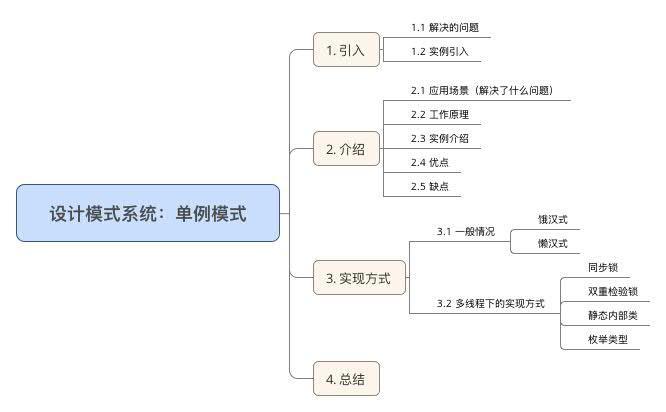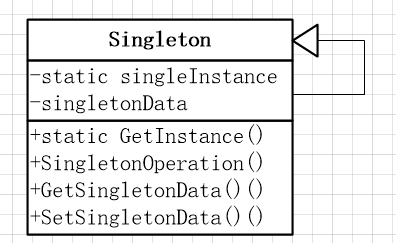單例模式 Singleton 簡單實例設計模式解析
前言
今天我來全面總結一下Android開發中最常用的設計模式 - 單例模式。
關于設計模式的介紹,可以看下我之前寫的:1分鐘全面了解“設計模式”
目錄

1. 引入
1.1 解決的是什么問題
之前說過,設計模式 = 某類特定問題的解決方案,那么單例模式是解決什么問題的解決方案呢?
含義:單例 =一個實例;
解決的問題:降低對象之間的耦合度
解決方法:單例模式,即實現一個類只有一個實例化對象,并提供一個全局訪問點
1.2 實例引入
接下來我用一個實例來對單例模式進行引入
背景:小成有一個塑料生產廠,但里面只有一個倉庫。
目的:想用代碼來實現倉庫的管理
現有做法: 建立倉庫類和工人類
其中,倉庫類里的quantity=商品數量;工人類里有搬運方法MoveIn(int i)和MoveOut(int i)。
出現的問題:通過測試發現,每次工人搬運操作都會新建一個倉庫,就是貨物都不是放在同一倉庫,這是怎么回事呢?(看下面代碼)
|
1
2
3
4
5
6
7
8
9
10
11
12
13
14
15
16
17
18
19
20
21
22
23
24
25
26
27
28
29
30
31
32
33
34
35
36
37
38
39
40
41
42
43
44
45
46
47
48
49
50
51
52
53
54
|
package scut.designmodel.SingletonPattern;//倉庫類class StoreHouse { private int quantity = 100; public void setQuantity(int quantity) { this.quantity = quantity; } public int getQuantity() { return quantity; }}//搬貨工人類class Carrier{ public StoreHouse mStoreHouse; public Carrier(StoreHouse storeHouse){ mStoreHouse = storeHouse; } //搬貨進倉庫 public void MoveIn(int i){ mStoreHouse.setQuantity(mStoreHouse.getQuantity()+i); } //搬貨出倉庫 public void MoveOut(int i){ mStoreHouse.setQuantity(mStoreHouse.getQuantity()-i); }}//工人搬運測試public class SinglePattern { public static void main(String[] args){ StoreHouse mStoreHouse1 = new StoreHouse(); StoreHouse mStoreHouse2 = new StoreHouse(); Carrier Carrier1 = new Carrier(mStoreHouse1); Carrier Carrier2 = new Carrier(mStoreHouse2); System.out.println("兩個是不是同一個?"); if(mStoreHouse1.equals(mStoreHouse2)){//這里用equals而不是用 == 符號,因為 == 符號只是比較兩個對象的地址 System.out.println("是同一個"); }else { System.out.println("不是同一個"); } //搬運工搬完貨物之后出來匯報倉庫商品數量 Carrier1.MoveIn(30); System.out.println("倉庫商品余量:"+Carrier1.mStoreHouse.getQuantity()); Carrier2.MoveOut(50); System.out.println("倉庫商品余量:"+Carrier2.mStoreHouse.getQuantity()); }} |
結果:
|
1
2
3
4
|
兩個是不是同一個?不是同一個倉庫商品余量:130倉庫商品余量:50 |
2. 單例模式介紹
2.1 解決的問題(應用場景)
沖突:從上面的結果可以看出,工人類操作的明顯不是同一個倉庫實例。
目標:全部工人操作的是同一個倉庫實例
單例模式就是為了解決這類問題的解決方案:實現一個類只有一個實例化對象,并提供一個全局訪問點2.2 工作原理
在Java中,我們通過使用對象(類實例化后)來操作這些類,類實例化是通過它的構造方法進行的,要是想實現一個類只有一個實例化對象,就要對類的構造方法下功夫:

單例模式的一般實現:(含使用步驟)
|
1
2
3
4
5
6
7
8
9
10
11
12
13
14
|
public class Singleton {//1. 創建私有變量 ourInstance(用以記錄 Singleton 的唯一實例)//2. 內部進行實例化 private static Singleton ourInstance = new Singleton();//3. 把類的構造方法私有化,不讓外部調用構造方法實例化 private Singleton() { }//4. 定義公有方法提供該類的全局唯一訪問點//5. 外部通過調用getInstance()方法來返回唯一的實例 public static Singleton newInstance() { return ourInstance; }} |
好了,單例模式的介紹和原理應該了解了吧?那么我們現在來解決上面小成出現的“倉庫不是一個”的問題吧!
2.3 實例介紹
小成使用單例模式改善上面例子的代碼:
|
1
2
3
4
5
6
7
8
9
10
11
12
13
14
15
16
17
18
19
20
21
22
23
24
25
26
27
28
29
30
31
32
33
34
35
36
37
38
39
40
41
42
43
44
45
46
47
48
49
50
51
52
53
54
55
56
57
58
59
60
61
62
63
64
65
66
67
68
69
|
package scut.designmodel.SingletonPattern;import java.util.concurrent.locks.Lock;import java.util.concurrent.locks.ReentrantLock;//單例倉庫類class StoreHouse { //倉庫商品數量 private int quantity = 100; //自己在內部實例化 private static StoreHouse ourInstance = new StoreHouse();; //讓外部通過調用getInstance()方法來返回唯一的實例。 public static StoreHouse getInstance() { return ourInstance; } //封閉構造函數 private StoreHouse() { } public void setQuantity(int quantity) { this.quantity = quantity; } public int getQuantity() { return quantity; }}//搬貨工人類class Carrier{ public StoreHouse mStoreHouse; public Carrier(StoreHouse storeHouse){ mStoreHouse = storeHouse; } //搬貨進倉庫 public void MoveIn(int i){ mStoreHouse.setQuantity(mStoreHouse.getQuantity()+i); } //搬貨出倉庫 public void MoveOut(int i){ mStoreHouse.setQuantity(mStoreHouse.getQuantity()-i); }}//工人搬運測試public class SinglePattern { public static void main(String[] args){ StoreHouse mStoreHouse1 = StoreHouse.getInstance(); StoreHouse mStoreHouse2 = StoreHouse.getInstance(); Carrier Carrier1 = new Carrier(mStoreHouse1); Carrier Carrier2 = new Carrier(mStoreHouse2); System.out.println("兩個是不是同一個?"); if(mStoreHouse1.equals(mStoreHouse2)){ System.out.println("是同一個"); }else { System.out.println("不是同一個"); } //搬運工搬完貨物之后出來匯報倉庫商品數量 Carrier1.MoveIn(30); System.out.println("倉庫商品余量:"+Carrier1.mStoreHouse.getQuantity()); Carrier2.MoveOut(50); System.out.println("倉庫商品余量:"+Carrier2.mStoreHouse.getQuantity()); }} |
結果:
|
1
2
3
4
|
兩個是不是同一個?是同一個倉庫商品余量:130倉庫商品余量:80 |
從結果分析,使用了單例模式后,倉庫類就只有一個倉庫實例了,再也不用擔心搬運工人進錯倉庫了!!!
2.4 優點
- 提供了對唯一實例的受控訪問;
- 由于在系統內存中只存在一個對象,因此可以節約系統資源,對于一些需要頻繁創建和銷毀的對象單例模式無疑可以提高系統的性能;
- 可以根據實際情況需要,在單例模式的基礎上擴展做出雙例模式,多例模式;
2.5 缺點
- 單例類的職責過重,里面的代碼可能會過于復雜,在一定程度上違背了“單一職責原則”。
- 如果實例化的對象長時間不被利用,會被系統認為是垃圾而被回收,這將導致對象狀態的丟失。
3. 單例模式的實現方式
3.1 一般情況
餓漢式(最簡單的單例實現方式)
|
1
2
3
4
5
6
7
8
9
10
|
class Singleton { private static Singleton ourInstance = new Singleton(); private Singleton() { } public static Singleton newInstance() { return ourInstance; }} |
應用場景:
- 要求直接在應用啟動時加載并初始化
- 單例對象要求初始化速度非常快且占用內存非常小
懶漢式
懶漢式與餓漢式最大的區別是單例的初始化操作的時機:
- 餓漢式:自動進行單例的初始化
- 懶漢式:有需要的時候才手動調用newInstance()進行單例的初始化操作
|
1
2
3
4
5
6
7
8
9
10
11
12
13
|
class Singleton { private static Singleton ourInstance = null; private Singleton() { } public static Singleton newInstance() { if( ourInstance == null){ ourInstance = new Singleton(); } return ourInstance; }} |
應用場景:
- 單例初始化的操作耗時比較長而應用對于啟動速度又有要求
- 單例的占用內存比較大
- 單例只是在某個特定場景的情況下才會被使用,即按需延遲加載單例。
3.2 多線程下的單例模式實現
在多線程的情況下:
- 對于“餓漢式單例模式”:適用,因為JVM只會加載一次單例類;
- 對于“懶漢式單例模式”:不適用,因為“懶漢式”在創建單例時是線程不安全的,多個線程可能會并發調用 newInstance 方法從而出現重復創建單例對象的問題。
解決方案1:同步鎖
使用同步鎖 synchronized (Singleton.class) 防止多線程同時進入造成instance被多次實例化。
|
1
2
3
4
5
6
7
8
9
10
11
12
13
14
15
|
class Singleton { private static Singleton ourInstance = null; private Singleton() { } public static Singleton newInstance() { synchronized (Singleton.class){ if( ourInstance == null){ ourInstance = new Singleton(); } } return ourInstance; }} |
解決方案2:雙重校驗鎖
在同步鎖的基礎上( synchronized (Singleton.class) 外)添加了一層if,這是為了在Instance已經實例化后下次進入不必執行 synchronized (Singleton.class) 獲取對象鎖,從而提高性能。
|
1
2
3
4
5
6
7
8
9
10
11
12
13
14
15
16
17
|
class Singleton { private static Singleton ourInstance = null; private Singleton() { } public static Singleton newInstance() {if( ourInstance == null){ synchronized (Singleton.class){ if( ourInstance == null){ ourInstance = new Singleton(); } } } return ourInstance; }} |
解決方案3:靜態內部類
在JVM進行類加載的時候會保證數據是同步的,我們采用內部類實現:在內部類里面去創建對象實例。
只要應用中不使用內部類 JVM 就不會去加載這個單例類,也就不會創建單例對象,從而實現“懶漢式”的延遲加載和線程安全。
|
1
2
3
4
5
6
7
8
9
10
11
12
13
|
class Singleton { //在裝載該內部類時才會去創建單例對象 private static class Singleton2{ private static Singleton ourInstance = new Singleton(); } private Singleton() { } public static Singleton newInstance() { return Singleton2.ourInstance; }} |
解決方案4:枚舉類型
最簡潔、易用的單例實現方式,(《Effective Java》推薦)
|
1
2
3
4
5
6
7
8
9
|
public enum Singleton{ //定義一個枚舉的元素,它就是Singleton的一個實例 instance; public void doSomething(){ } } |
使用方式如下:
|
1
2
|
Singleton singleton = Singleton.instance;singleton.doSomething(); |
5. 總結
本文主要對單例模式進行了全面介紹,包括原理和實現方式,接下來我會繼續講解其他設計模式,有興趣可以繼續關注
感謝閱讀,希望能幫助到大家,謝謝大家對本站的支持!
原文鏈接:http://blog.csdn.net/carson_ho/article/details/52223097














